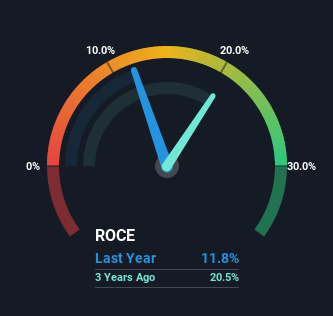- Hong Kong
- /
- Trade Distributors
- /
- SEHK:2102
Tak Lee Machinery Holdings (HKG:2102) May Have Issues Allocating Its Capital

If you're looking for a multi-bagger, there's a few things to keep an eye out for. In a perfect world, we'd like to see a company investing more capital into its business and ideally the returns earned from that capital are also increasing. This shows us that it's a compounding machine, able to continually reinvest its earnings back into the business and generate higher returns. However, after briefly looking over the numbers, we don't think Tak Lee Machinery Holdings (HKG:2102) has the makings of a multi-bagger going forward, but let's have a look at why that may be.
What is Return On Capital Employed (ROCE)?
For those that aren't sure what ROCE is, it measures the amount of pre-tax profits a company can generate from the capital employed in its business. The formula for this calculation on Tak Lee Machinery Holdings is:
Return on Capital Employed = Earnings Before Interest and Tax (EBIT) ÷ (Total Assets - Current Liabilities)
0.12 = HK$53m ÷ (HK$485m - HK$36m) (Based on the trailing twelve months to January 2022).
Therefore, Tak Lee Machinery Holdings has an ROCE of 12%. On its own, that's a standard return, however it's much better than the 4.3% generated by the Trade Distributors industry.
See our latest analysis for Tak Lee Machinery Holdings

Historical performance is a great place to start when researching a stock so above you can see the gauge for Tak Lee Machinery Holdings' ROCE against it's prior returns. If you're interested in investigating Tak Lee Machinery Holdings' past further, check out this free graph of past earnings, revenue and cash flow.
The Trend Of ROCE
On the surface, the trend of ROCE at Tak Lee Machinery Holdings doesn't inspire confidence. Over the last five years, returns on capital have decreased to 12% from 16% five years ago. Given the business is employing more capital while revenue has slipped, this is a bit concerning. This could mean that the business is losing its competitive advantage or market share, because while more money is being put into ventures, it's actually producing a lower return - "less bang for their buck" per se.
On a side note, Tak Lee Machinery Holdings has done well to pay down its current liabilities to 7.4% of total assets. That could partly explain why the ROCE has dropped. Effectively this means their suppliers or short-term creditors are funding less of the business, which reduces some elements of risk. Since the business is basically funding more of its operations with it's own money, you could argue this has made the business less efficient at generating ROCE.
The Bottom Line
We're a bit apprehensive about Tak Lee Machinery Holdings because despite more capital being deployed in the business, returns on that capital and sales have both fallen. In spite of that, the stock has delivered a 13% return to shareholders who held over the last three years. Either way, we aren't huge fans of the current trends and so with that we think you might find better investments elsewhere.
Like most companies, Tak Lee Machinery Holdings does come with some risks, and we've found 2 warning signs that you should be aware of.
While Tak Lee Machinery Holdings isn't earning the highest return, check out this free list of companies that are earning high returns on equity with solid balance sheets.
Valuation is complex, but we're here to simplify it.
Discover if Tak Lee Machinery Holdings might be undervalued or overvalued with our detailed analysis, featuring fair value estimates, potential risks, dividends, insider trades, and its financial condition.
Access Free AnalysisHave feedback on this article? Concerned about the content? Get in touch with us directly. Alternatively, email editorial-team (at) simplywallst.com.
This article by Simply Wall St is general in nature. We provide commentary based on historical data and analyst forecasts only using an unbiased methodology and our articles are not intended to be financial advice. It does not constitute a recommendation to buy or sell any stock, and does not take account of your objectives, or your financial situation. We aim to bring you long-term focused analysis driven by fundamental data. Note that our analysis may not factor in the latest price-sensitive company announcements or qualitative material. Simply Wall St has no position in any stocks mentioned.
About SEHK:2102
Tak Lee Machinery Holdings
An investment holding company, engages in the sale and leasing of new and used earthmoving equipment and spare parts in Hong Kong.
Flawless balance sheet with proven track record.
Market Insights
Community Narratives



